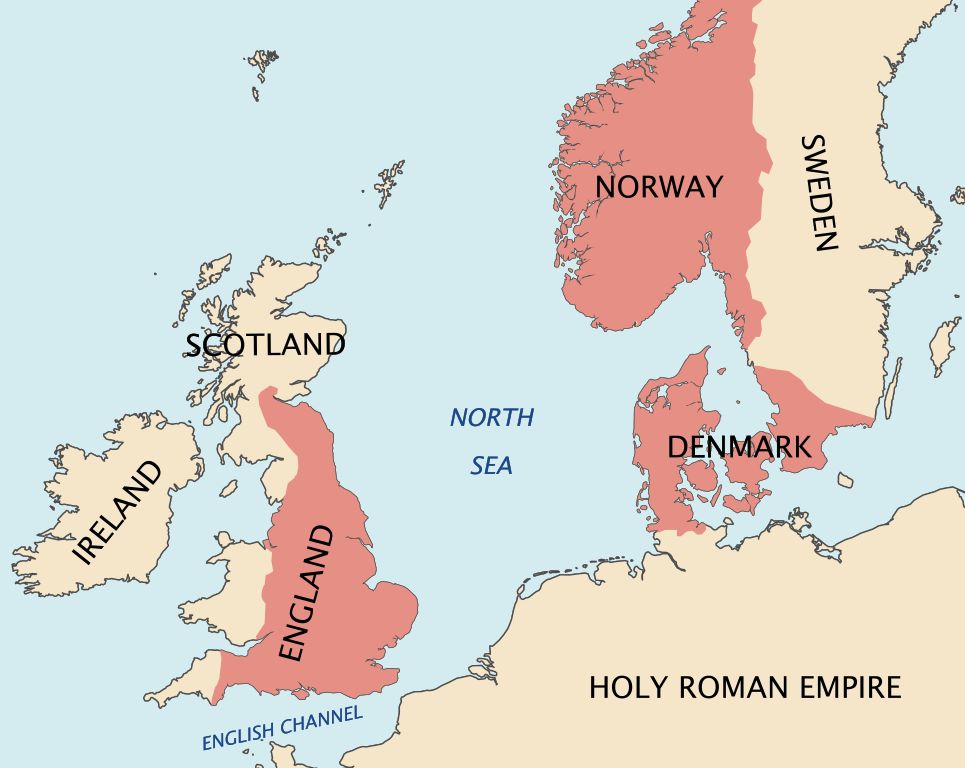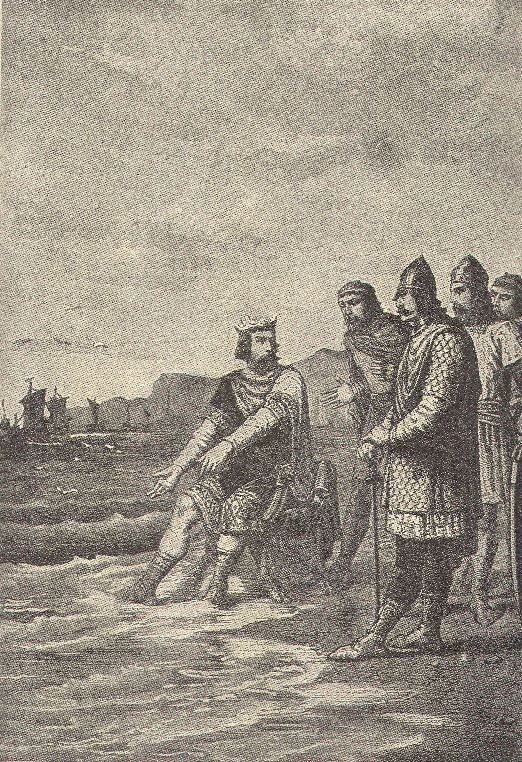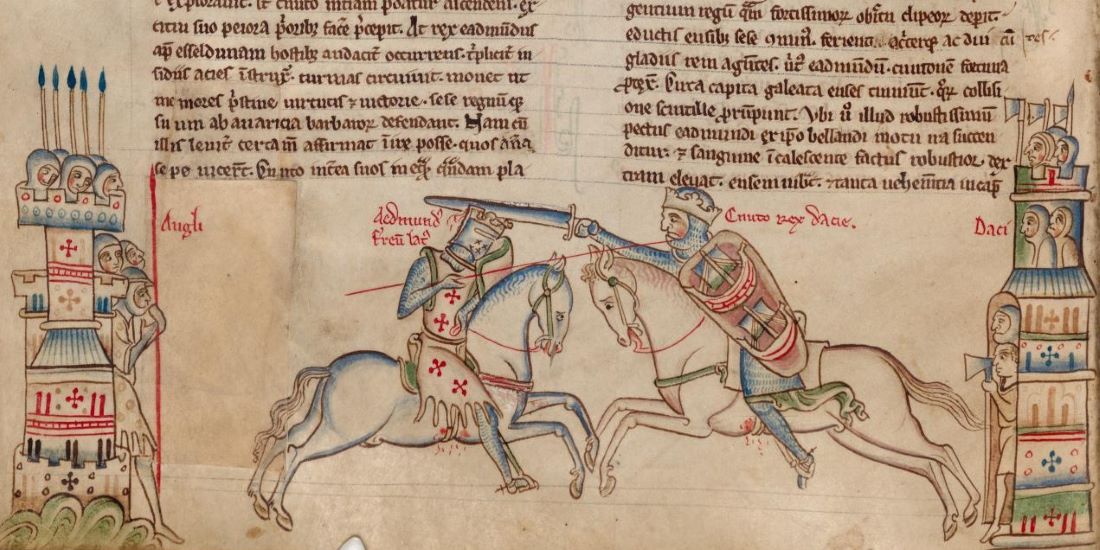Cnut the Great, the first ruler to preside over the combined realms of modern-day England, Denmark, Norway, and parts of Sweden, stands as a monumental figure in the annals of the North Sea Empire. His tenure marked a period of significant expansion and consolidation, showcasing his political acumen and military might. This brief overview aims to highlight the key aspects of Cnut’s reign, from his strategic alliances and conquests to the administrative innovations that underpinned his expansive rule. In doing so, we set the stage for a more detailed examination of his impact and legacy, which left an indelible mark on the history of Northern Europe.
Cnut the Great’s Ascent to the English Throne
Cnut the Great’s path to becoming the King of England was intricately tied to his lineage and the volatile political climate of his time. He was the son of Sweyn Forkbeard, the ambitious King of Denmark, who extended his rule to England after numerous invasions. Following Sweyn’s death in 1014, the Danish throne initially eluded Cnut. However, his determination and strategic acumen soon reclaimed his position of power.

The journey to Cnut’s kingship was fraught with challenges. After Sweyn’s demise, the English nobility reinstated Aethelred the Unready, whose rule had been weakened by Danish incursions and internal strife. Seizing the opportunity, Cnut launched an invasion in 1015, exploiting the weakened English defenses and the deteriorating health of Aethelred. Upon Aethelred’s death in 1016, a power vacuum emerged, leading to a series of confrontations with Aethelred’s son, Edmund Ironside. The conflict culminated in the Treaty of Deerhurst, dividing the kingdom between the two. However, Edmund’s untimely death later that year left Cnut as the sole ruler of England, marking the start of a new era under his domain.
Cnut the Great: A Conqueror’s Transformation into a Christian King
Upon ascending the English throne, Cnut the Great demonstrated a governance style that distinguished him from the stereotypical Viking conqueror. His reign was characterized by a sophisticated blend of might, diplomacy, and respect for the established traditions of his new kingdom. Cnut embraced Christianity fervently, aligning himself with the church to legitimize his rule and unify his subjects. This strategic alliance was a clear departure from the pagan ways of his Viking predecessors and helped consolidate his power across the religiously devout nation.
Cnut’s respect for English traditions and laws was evident in his administrative choices. He retained much of the existing Anglo-Saxon system of governance, understanding the importance of continuity and stability. By upholding the laws and customs of his English subjects, Cnut fostered a sense of continuity and stability, easing the transition between regimes. This approach not only pacified his newly acquired subjects but also strengthened the internal stability of the kingdom. Furthermore, his marriage to Emma of Normandy, the widow of the previous king, Aethelred the Unready, was a tactical move that helped secure his position. This union symbolized a merging of Danish and English royal lines, further legitimizing his rule and promoting a sense of unity among the English nobility and populace.
Cnut’s rule was not just about maintaining order and tradition; it was also about demonstrating a benevolent and just kingship. He actively participated in church affairs, made generous donations, and went on pilgrimages, all of which were actions designed to endear him to his subjects and God. By positioning himself as a devout Christian king who respected and upheld the laws and customs of England, Cnut ensured his acceptance and respect among the English people. His reign was marked by relative peace and prosperity, a testament to his effective rule and the wise incorporation of the existing English system into his Scandinavian empire.
Consolidating the North Sea Empire
Cnut the Great’s expansion into the North Sea realms was a series of calculated moves marked by significant challenges and formidable opponents. In Denmark, the task was relatively straightforward due to his legitimate claim as the son of Sweyn Forkbeard. However, maintaining the loyalty of Danish nobles and securing the borders required continuous diplomatic and military efforts. He faced opposition from rival claimants and had to navigate the complex dynamics of Viking-age politics, where alliances were fragile and power was often contested.

Norway presented a different set of challenges. Here, Cnut faced resistance from King Olaf Haraldsson, whose claim to the Norwegian throne was backed by a strong local following and a reputation for fierce independence. Cnut’s strategy involved a combination of military force and alliance-building with Norwegian nobles disillusioned with Olaf’s rule. The task was arduous and required a sustained effort to fully integrate Norway into his realm. Cnut’s success was partly due to his ability to position himself not just as a conqueror but as a ruler who could bring stability and protection to the region.
The concept of the North Sea Empire is central to understanding Cnut’s achievements. This empire was not just a collection of territories but a network of maritime dominions spanning England, Denmark, Norway, and parts of Sweden. It represented control over crucial trade routes, enhanced political leverage in the region, and a formidable naval presence. The North Sea Empire was a testament to Cnut’s vision and ability to rule over a diverse and expansive realm, bringing together different cultures and regions under a single, powerful monarchy. His reign marked a rare period of relative peace and stability in the volatile world of Viking-age politics and warfare.
The Legacy of Cnut the Great
Cnut the Great’s reign from 1016 to 1035 marked a significant epoch in the history of Northern Europe. As a ruler, he demonstrated a unique blend of military might, diplomatic skills, and a keen understanding of the diverse cultures over which he ruled.
Upon his death in 1035, Cnut’s empire began to unravel as his sons, Harold Harefoot and Harthacnut, struggled to maintain the vast territories their father had united. Harold’s reign in England was short-lived, lasting only until 1040, and was marked by internal strife and challenges to his legitimacy. Harthacnut succeeded his brother but ruled for only a brief period until he died in 1042. The rapid decline of the North Sea Empire after Cnut’s death highlighted the personal nature of his rule and the challenges of sustaining such a vast dominion. The legacy of Cnut the Great, while marked by the brief duration of his empire, remains a significant period of relative peace, prosperity, and cultural exchange in the turbulent medieval North Sea region.
Cnut the Great and the Tide
The anecdote of Cnut the Great commanding the tide to halt is one of the most enduring legends about his reign, encapsulating the king’s wisdom and humility. This story, which first appears in historical texts several generations after Cnut’s death, is notably chronicled in Henry of Huntingdon’s 12th-century work, “Historia Anglorum.” According to this account, Cnut positioned his throne at the water’s edge as the tide advanced, commanding it not to wet his garments or limbs, asserting his dominion over it. Yet, the sea, indifferent to his commands, continued its natural course, soaking the king’s feet and shins.

At this moment, Cnut’s reaction was one of deliberate insight; he declared that true power lies only with God, who commands the heavens, earth, and sea. This symbolic act was not a display of arrogance but a calculated lesson to demonstrate the limits of human authority and the supremacy of the divine order. Through this gesture, Cnut sought to remind his courtiers and subjects that no king, regardless of his earthly power, could command the natural world, a realm governed solely by the Almighty.
Historical Challenge: Can You Conquer the Past?
Answer more than 18 questions correctly, and you will win a copy of History Chronicles Magazine Vol 1! Take our interactive history quiz now and put your knowledge to the test!

